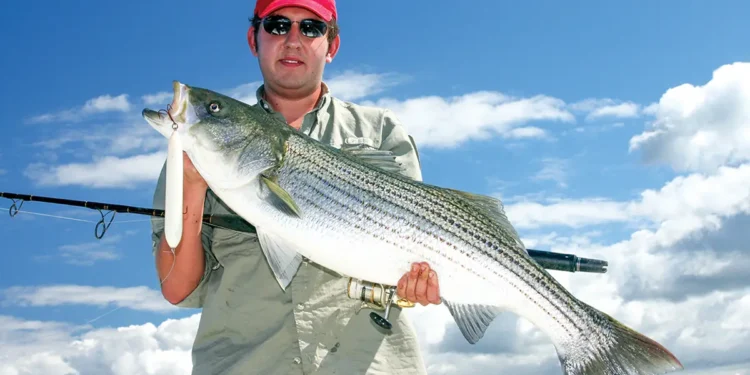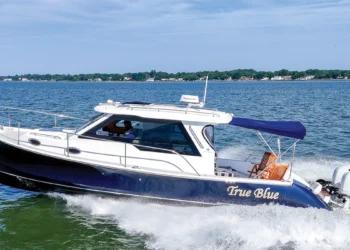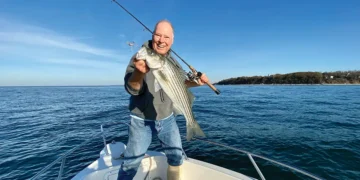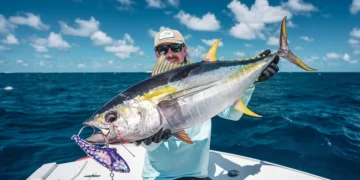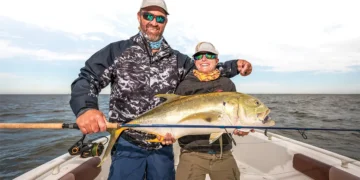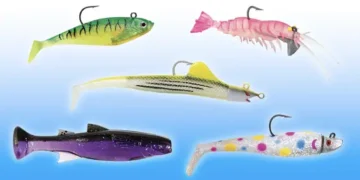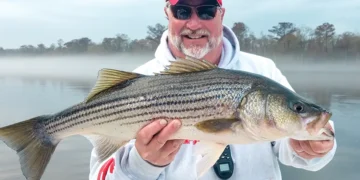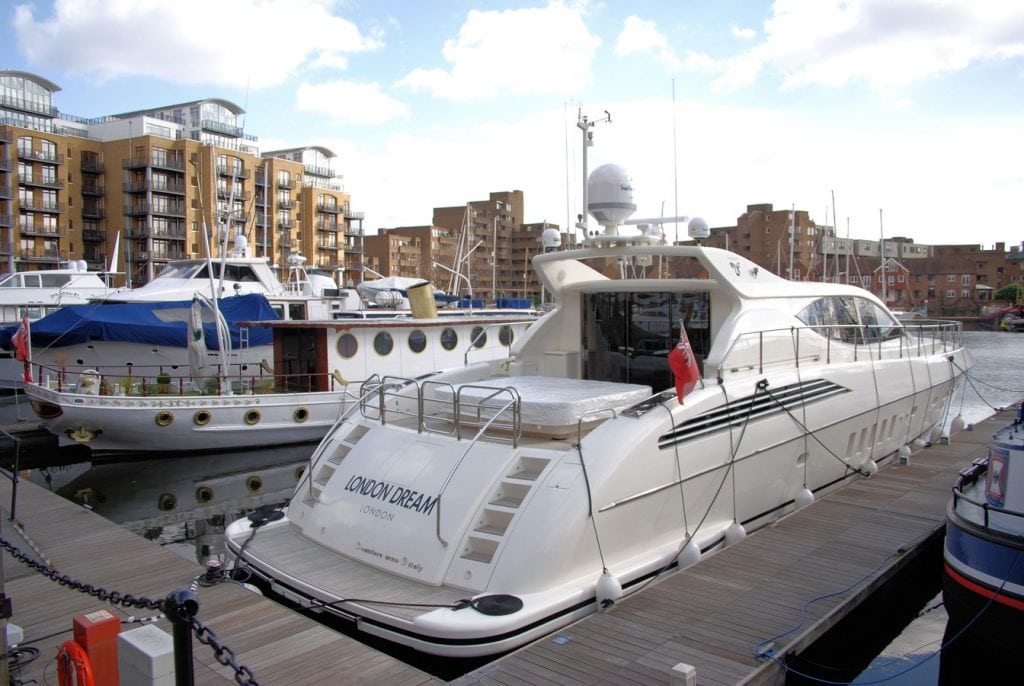This technique for working surface lures can really spark the bite.
“Grab one of those rods and get ready!” called out BJ Silvia from the wheelhouse. “We’ve got fish busting on top just ahead.”
Arden Gardell didn’t need to be told twice. Within seconds, he had a long, thin-profiled “spook-style” surface lure in the air and heading for the breaking stripers. With a few deft jerks of the rod, the big, white, tubular lure zigged and zagged across the surface. It didn’t get halfway back to the boat before a slot-sized striper gave it a slam.
Also Read
True North 34 (2022): Bow Thruster, 34-kt Top, Hampton VA
True North 34 (2022): Low-Hour Twin 300s True Blue offers classic looks, remarkable performance, and a sociable layout all within...
“It’s amazing how these spook-type lures call predators to the top even over deep water,” said Silvia, as he measured the striper and approved it fit for the cooler. “If you learn how to work them right, you can catch fish just about anywhere from the flats to the channels.”
Experienced saltwater fans have been throwing the big surface lures for years now with great success. These days, they are not only used to tempt cow stripers but other species, including big snook, tarpon, jacks, and tuna.
“I like to throw the nine-inch Muskie Mania and the new eight-and-a-quarter-inch Hogy XL Dogwalker in white and sometimes bright pink,” reveals Silvia, who skippers Flippin Out Charters. Based out of Newport, Rhode Island, he patrols the waters of Narragansett Bay and the ocean between Newport and Block Island for blackfish, stripers, fluke, sea bass, and scup.
Subscribe Here For More Boating Content
“This really is a special place,” continues Silvia of the beautiful and expansive bay. “We have an amazing range of bottom types here from channels and flats to rocky and sandy, heavy structure, bridge abutments, and more. Like most areas, each spot has its own set of conditions under which it produces best, but all of them can give up solid fish to these surface lures if you time things right.”
“What it really takes to bring out the best in predators when using spook-style surface lures is mastering a walk-the-dog retrieve,” says Gardell, owner of the popular Little Fish restaurant on Long Island, New York’s North Fork. “You’ve got to learn how to use your rod tip to slide that lure across the surface with an exaggerated zig-zag pattern. It does take some practice. I tell people that the further they can get the lure to slide from one side to the other, the better they’re likely to do.”
Walk-the-Dog Retrieve (quick steps):
Point the rod tip down near the water.
Pop the tip while giving a touch of slack.
Repeat in a steady rhythm so the lure zig-zags wide.
Keep moving on follows—don’t slow down.
Set the hook only after you feel the rod load.
Silvia agrees, adding a more exaggerated slide back and forth is needed to pull big fish from deeper water than in the shallows. Also, rather than varying the cadence of your retrieve, he suggests keeping a steady pace and never slowing down the lure for a fish giving chase.
Also Read:
Sport Express Cruiser Buyers’ Guide: 22 Standout Boats Going Into 2026
Performance and power come together in 22 versatile vessels. Quick Facts Coverage: 22 sport express cruisers across cats,...
Of course, to get the job done, you’ll need a setup with some backbone and reel strength. Silvia recommends a Jigging World Nexis 7-foot, 6-inch medium/heavy rod, teamed with a Shimano 4000 Twin Power spinning reel spooled with 30-pound-test braid. “That long rod catapults the lure out far from the boat,” he explains, “and the lightweight but strong reel has the guts to keep that lure coming or to turn a big fish if necessary.”
Gear at a Glance:
Rod: 7’6” MH spinning
Reel: 4000 size, strong drag
Line: 30-lb braid + 20–40 lb leader
Lures: 8–9″ walkers in white or pink
Realizing how much adrenaline is flowing as a large predator species homes in on these offerings, the best anglers quickly learn to keep their reflexes under control and resist setting the hook on the eruption, waiting instead to feel the rod load before driving home their points.
As things panned out, we had to work for our fish on this trip, but that’s part of the fun. It took a little time, but we eventually iced nearly a full limit of ‘tog to five pounds, caught several stripers on spook lures and soft-plastic swim shads, released plenty of shorts, and iced a solid pile of fillets before heading home.
-by Tom Schlichter
People Also Ask:
What is a spook-style lure? A long, cigar-shaped topwater plug designed to zig-zag on a “walk-the-dog” retrieve.
Best retrieve speed? Steady cadence; exaggerate side-to-side in deeper water.
When does topwater shine for stripers? Low light, calm mornings/evenings, surface feeds, rips and edges.
Best colors? White most days; bright/pink in low light or stained water.
Do I set on the splash? No—wait to feel weight, then drive the hooks.


